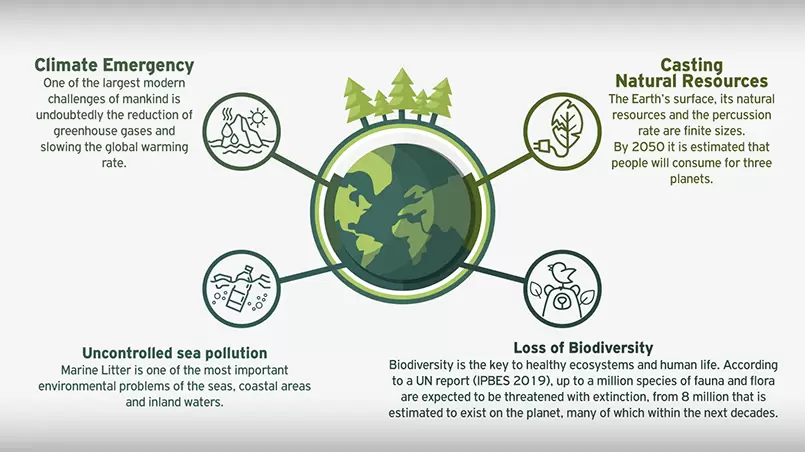Why we care for the Environment
Our Planet and Climate Change
Human activities significantly affect our planet’s climate and temperature.
More specifically, the activities accompanied by the use and combustion of fossil fuels, deforestation, and livestock have been releasing greenhouse gases, and as a result have intensified the greenhouse effect, which inevitably led to global warming.
Greenhouse gases exist in nature, however human activity results in the increase of concentrations of some of them in the atmosphere, such as the following:
- Carbon Dioxide (CO2)
- Μethane
- Nitrous oxide
- Fluorinated gases
“The period 2011-2020 was the warmest decade ever recorded, as global average temperatures exceeded pre-industrial levels by 1.1 ° C in 2019. Anthropogenic global warming is currently increasing at a rate of 0.2 °C per decade.
An increase in temperature of 2 °C compared to the pre-industrial era is associated with serious adverse effects on the natural environment and human health and well-being, as well as a much higher risk of dangerous and potentially catastrophic changes in the global environment.
For this reason, the international community has recognized the need to keep the temperature rise well below 2 °C and to continue efforts to reduce it to 1.5 ° C”. (Source: EU Official site for the Climate Change: https://ec.europa.eu/clima/change/causes_en
The effects of climate change and global warming have been evident for decades, but nowadays the problem is intensifying rapidly, affecting many sectors, by creating risks such as:
- Rising sea levels
- Extreme weather conditions (rainfalls, floods, snowfalls)
- Risks regarding human health, flora and fauna
- Risks for the Economy and Society
Our Planet is sending out an S.O.S.
- Climate emergency: The IPCC report “Special Report Global Warming of 1.5°C: (2018)”, describes in detail the effects of a 1.5°C rise in global temperature above pre-industrial levels, while indicating that humanity has only 12 years to reduce total net anthropogenic emissions of CO2 by approximately 45% compared to 2005 levels, reaching “net zero” circa 2050.
- Waste of natural resources: Global consumption of materials such as biomass, fossil fuels, metals, and minerals, is expected to double within the next 40 years, while the annual waste production is projected to increase by 70% until 2050. In addition, mining and processing of resources creates 50% of total greenhouse gas emissions and more than 90% of biodiversity loss and water resources pressure.

- Biodiversity loss: Some researchers estimate that we are already going through the sixth mass extinction of the dominant life forms in the history of the earth. Previous mass extinctions have wiped out between 60% and 95% of all species. Ecosystems need millions of years to bring life back to previous levels of diversity.
- Uncontrolled marine pollution: Marine litter is a global challenge, with a particularly high presence in the Mediterranean Sea. It is attributed to the improper disposal of fishery and consumer products, as well as to the low efficiency of the existing waste management infrastructure, recycling, and source sorting systems. At the same time, overfishing, aquaculture, coastal landfills, urban and industrial discharges, tourism, shipping, further increase the risk for marine life and the degradation of ecosystem services. Plastics as materials are used daily in our lives, but they should be used responsibly by the citizens, recycled as much as possible and kept away from our seas.